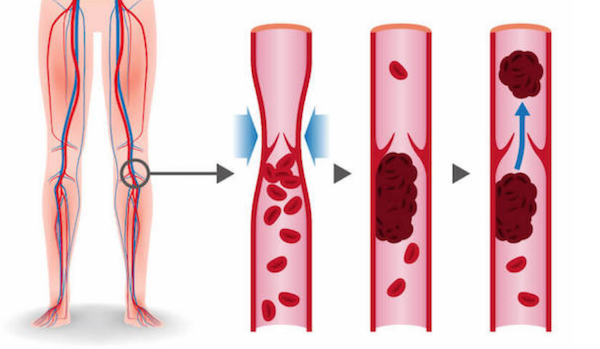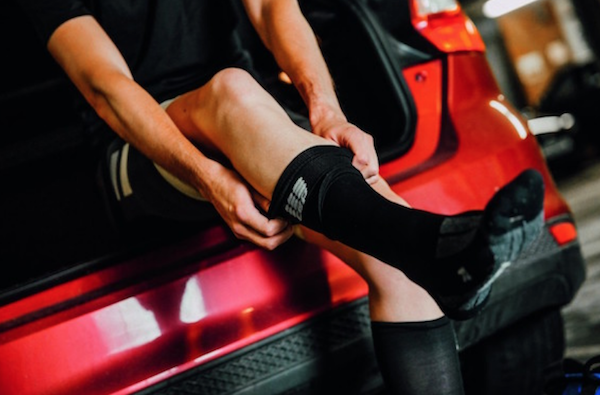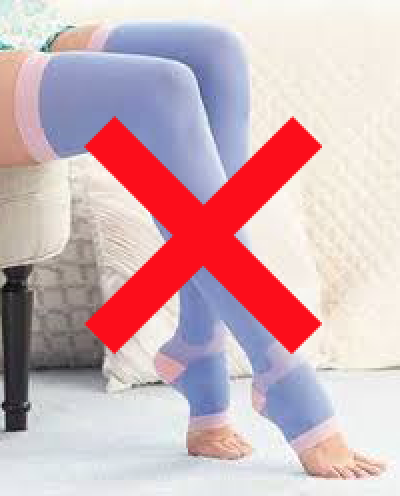Compression socks are also called compression stockings and compression sleeves.
They are worn on your legs to boost your circulation, decrease the risk of blood clots and swelling, and even improve your recovery time following an intense workout.
What Do Compression Socks Do?
Compression socks treat many different conditions, including deep vein thrombosis (DVT), lymphedema, varicose veins, chronic venous insufficiency, and edema (swelling).
Pregnant women are at risk for these types of conditions due to blood and fluid volume changes, as are patients with a history of blood clots.
Luckily, compression socks help prevent blood clots.
These compression stockings also benefit athletes during running and hiking because they improve circulation and recovery time.
Why Wear Compression Legwear?

Wearing compression socks minimizes the feeling of “heaviness” in your legs. Stockings decrease swelling in the legs and improve blood flow in the legs for better leg health. The socks may be a bit difficult to pull on at first because the reason that they work is that they are snug. However, the more you put them on, the better you get at it! Eventually, putting them on is second nature, and you are relishing in all the healthy benefits.
How Do They Work?
When wearing compression socks correctly, they help pump blood from the legs back towards the heart to accelerate better blood flow. The calf muscle and superficial veins of the legs have valves that also help to return the blood.
The pressure from the compression stockings helps to move the blood back up despite gravity. Most commonly, your provider will recommend wearing the compression stockings on both legs. It is rare but not impossible to wear compression stockings on only one leg.
Popular Articles on ComproGear
Compression Stockings mmHg Chart Compression Socks Strengths
Who Benefits From Wearing Them?

Does everyone need to wear compression socks all the time, everywhere? People who should wear compression socks spend time on their feet regularly or those who are stationary and sit for many hours during the day. Stockings are also ideal for those who are traveling, pregnant, or athletes (particularly runners), and persons with comorbidities, such as DVT and chronic venous occlusion. Furthermore, you should wear stockings following surgery to reduce complications.
They Come in Different Lengths to Cater to Your Needs

You will select the length of the compression socks based on why you are wearing them. If there’s not a medical reason, you also may consider which is the most comfortable for you to wear.
The main options include thing-level stockings and knee-high stockings. Knee-high socks are easier to tolerate by the user, as the power of compression sometimes comes at the cost of a little unpleasantness. Stocking size is significant, as it is necessary to wear the correct stocking length. For example, wearing knee-high stockings for the treatment of varicose veins in the thighs will have no therapeutic effect.
Choosing the Right Pair For Yourself

There are many types of compression legwear in the market, like compression sleeves, stockings, or tights. These are all medically proven to be efficient and effective to help in treating and preventing a multitude of medical conditions by promoting better blood flow in the lower legs.
You can find a variety of compression stockings in our store online. Most benefit from wearing these magical medical devices but always discuss with your provider before purchasing.
When are They Right for Me?
There are many reasons that people use compression socks. You don’t even have to be diagnosed with medical conditions to enjoy the health benefits and positive effects of wearing compression legwear. Any person with swollen legs can improve the symptoms by wearing a low gradient of compression of the compression legwear. In the event of recent deep vein thrombosis, you should wear higher gradient compression socks. While compression socks are a considerable preventive measure against medical conditions, ask your healthcare provider a prescription. If something doesn’t feel right or you have any concerns about your health, reach out to your provider.
What are the Health Benefits for Pregnant Women wearing compression stockings?

Pregnancy has many challenges. One of them is the shifting fluid volume that appears when a pregnant woman stands. Symptoms include painful or swollen feet and a feeling of heaviness in the legs. Compression stockings can help alleviate the pain and swelling of the legs and feet. Research shows that wearing compression legwear decreases lower limb edema for pregnant women during the third trimester and help prevent DVT after delivery.
Combating Deep Vein Thrombosis (DVT)
Deep vein thrombosis (DVT), also known as deep venous thrombosis, is a serious and dangerous disease that can result in death. It requires anticoagulant medication regularly following the discovery of a clot. However, immediately following the diagnosis of DVT, the treatment requires immediate medical support. Such patients have a long road to recovery. Not only is it important to make sure you get enough rest and proper treatment, but it is also common to wear the compression stockings as a crucial part of the therapy.
Who Should Not Wear These Socks?

Although compression stockings can be super beneficial, some conditions that are not compatible with wearing them. If you suffer from heart failure, advanced peripheral arterial disease, advanced peripheral nephropathy, uncontrolled congestive heart failure, or localized lesions like oozing dermatitis, you should not wear compression socks.
The benefits of using the stockings are weighed on a case-by-case basis by physicians. Generally, though, the presence of the advanced arterial peripheral disease is a contraindication for the use of circulation legwear as it can affect arterial blood flow out to your limbs.
What are the Side Effects of Wearing Them?

Are they harmful? While there are a few side effects that can occur when you wear compression stockings, most of them are more related to discomfort than harm. Some users dislike the feeling of pressure or itching or tingling. Some customers complain of minor calluses.
Sometimes, it’s easy to get used to these minor concerns over time. Other users experience an allergy to the sock. Double-check that you’re not allergic to the materials in the socks by checking the label and wash the stockings according to directions. However, if any of these symptoms worsen or fail to get better, you should speak with your healthcare provider ASAP. There is a small possibility it could be a neuropathy (nerve issue) or skin disease.
Why Should You Try Compression Socks?
Hopefully, this sheds some light on why you should wear compression socks. There are even styles and lengths that you can pick based on your preference.
While wearing compression socks is important, choosing the right compression pressure level for you is also essential. If you’re not sure which level of compression stocking to use, consult a healthcare provider or read about how to choose your compression stocking.
Last but not least, always browse and compare then read the product description when you are purchasing online. Now that you know more about compression stockings, you should jump right in!
